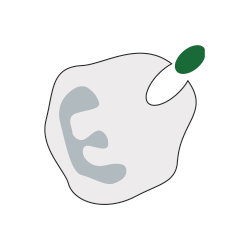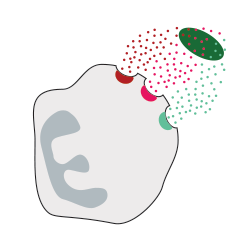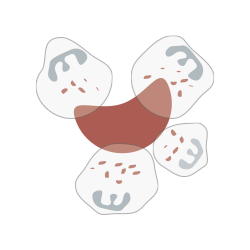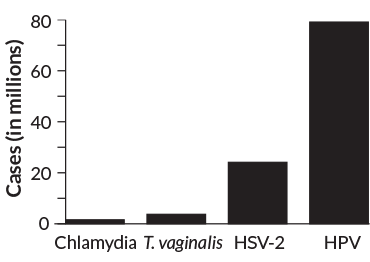How an obscure sexually transmitted parasite tangos with the immune system
Trichomonas vaginalis also enlists helpers to battle other microbes
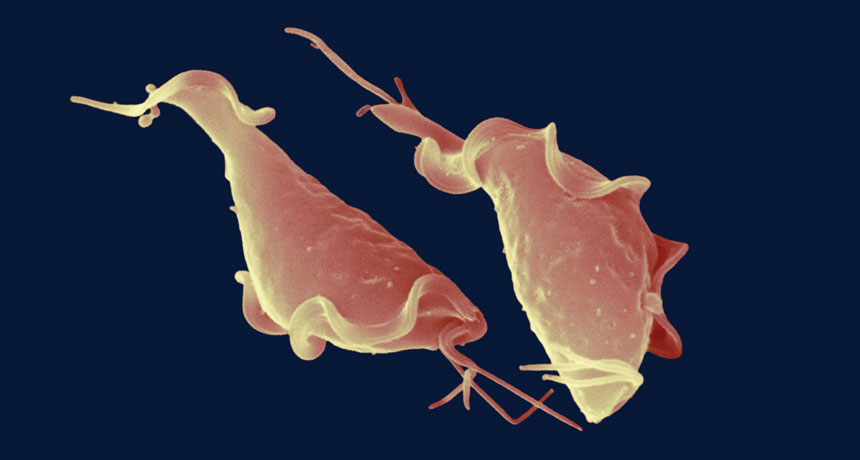
TRICKY PARASITE Trichomonas vaginalis has a funny shape and some clever ways of infecting people.
David M. Phillips/Science Source
Frances Mercer runs a fight club.
In one corner, the parasite Trichomonas vaginalis, which causes a widespread sexually transmitted infection that many people have never heard of. In the other corner are neutrophils, the immune system cells best equipped to take down the aggressor.
Watching the two battle it out, Mercer, an immunoparasitologist at California State Polytechnic University in Pomona, has learned a lot about the parasite. And she’s shown exactly how neutrophils manage to take down T. vaginalis — using a maneuver that scientists didn’t even know the immune cells possessed.
A focus on T. vaginalis has been a long time coming. In 2016, the parasite was responsible for about 156 million worldwide cases of the sexually transmitted infection called trichomoniasis in men and women. In the United States, trichomoniasis is the third most common sexually transmitted infection after HPV, or human papillomavirus, and herpes.
Today, scientists are just beginning to get a handle on how the parasite causes trouble — including increasing risk for HIV infection, infertility and preterm delivery — and how the human immune system fights back. Complicating the picture is the fact that T. vaginalis doesn’t work alone. Other microbes living inside the vagina, and some inside the parasite itself, get into the fray.
Not just a nuisance
The infection “is not taken very seriously; it’s thought of as making women a bit itchy down there,” says Jane Carlton, a parasitologist at the New York University Center for Genomics and Systems Biology. As its name suggests, T. vaginalis colonizes the vagina, but it can also find a home in the urethra, which carries urine, in both men and women.
“One person’s nuisance infection is another person’s raving, itchy, hot, burning infection,” Carlton adds. About one-third or more of women who have an infection will have itch, discomfort or discharge — probably due to the action of the immune cells fighting the parasite, Mercer says.
About 5 to 10 percent of infected men suffer similar symptoms. The infection can be treated with metronidazole, a parasite-killing antibiotic, but about 5 percent of parasites are resistant to the drug.
Left untreated, trichomoniasis can have long-term consequences. The infection about doubles a woman’s chances of acquiring HIV. The risk might go up, Mercer says, because the parasite damages the barrier between the vaginal wall and the rest of the body, or because it causes an influx of the immune system’s T cells, which are the target of HIV infections. The parasite also interferes with female fertility and pregnancy. In men, T. vaginalis has been tentatively linked to infertility and prostate cancer.
Plus, the parasite can infect the same person more than once. Unlike with many other microbes, the immune system seems to be lousy at remembering how to fight T. vaginalis. The invader may even manipulate the immune response to block that memory, speculates Daniele Dessì, a microbiologist at the University of Sassari in Italy, with a touch of awe: “This is quite amazing for such a primitive organism.”
T. vaginalis is one of three species of trichomonad that infect humans. Scientists think trichomonads, single-celled protozoans, may have been among the first organisms to branch off the evolutionary tree after the rise of the original eukaryote, the ancestor of all animals, plants, fungi and protozoans.
“Learning about Trichomonas vaginalis is like learning about our own origins — who we were at the beginning,” says parasitologist Augusto Simoes-Barbosa of the University of Auckland in New Zealand. “Probably our ancestor was a very complex organism.”
At some point in its history — scientists don’t know when — T. vaginalis found the vagina a suitable place to live. It’s a good choice, points out Carlton: warm, moist, with plentiful sources of nutrition. Plus, men provide a convenient shuttle service to the next vagina.
Transmitted by sexual contact, the pear-shaped parasite swims into the vagina, paddling with tail-like flagella. T. vaginalis then sprawls out, amoeba-like, among the cells lining the vagina and cervix, rupturing them and eating the pieces.
Duel in a dish
Mercer first began investigating the parasite in 2013, as a postdoc in the lab of Patricia Johnson, a parasitologist at UCLA. At the time, not much was known about how T. vaginalis interacted with the immune system.
So Mercer set up her fight club, pitting the parasite against various immune cells in laboratory dishes. The parasite killed T cells and B cells, she reported with Johnson and colleagues in PLOS Neglected Tropical Diseases in 2016. The parasite seems to poison the cells, Mercer says, and may also gobble them up. B cells help the body remember past infections. So their loss may help explain why a person can get trichomoniasis multiple times. T. vaginalis was less effective at killing another type of immune cell, monocytes, which have a variety of roles, including swallowing invaders and helping T cells learn about pathogens.
One type of immune cell stood out: Neutrophils slaughtered the parasite in just 10 minutes. Neutrophils are the body’s first line of defense, so their action wasn’t a big surprise. These cells, “the foot soldiers of the immune system,” Mercer calls them, are drawn to infections when cells send out a distress call: the molecule interleukin-8, or IL-8.
The surprise came when Mercer, Johnson and colleagues learned how neutrophils fight the parasite. The team reported its findings in February 2018 in PLOS Biology. Neutrophils were known to kill invaders in three ways. The first, phagocytosis, involves swallowing pathogens whole. But Mercer didn’t think that was happening with T. vaginalis. The parasites are about 20 percent bigger than the immune cells, so Mercer doubted the neutrophils could catch and guzzle the larger pathogen, especially one capable of swimming away.Second, neutrophils spew toxins. But Mercer found that the neutrophils needed to be touching T. vaginalis to kill it; the immune cells weren’t just hurling chemical bombs from afar.
The third strategy, called NETosis, is the weirdest. A kamikaze neutrophil vomits its own DNA onto a parasite, entangling and killing its prey in the strands. Yet when Mercer added chemicals to destroy the vomited DNA in the lab dishes, neutrophils could still slay the parasites. No NETosis here.
At a dead end, Mercer took a second look at phagocytosis. And indeed, chemicals that prevent phagocytosis stopped neutrophils from killing T. vaginalis. “We were confused,” Mercer recalls. “How is the neutrophil engulfing something that is bigger than it?”
She got her answer when she dyed neutrophils one color and parasites another, and put them together. She often found neutrophils containing a smidge of parasite coloring. When she looked under the microscope, she caught the neutrophils in the act. Three to six neutrophils surrounded a parasite and nibbled it to death, a process called trogocytosis. Within about three to eight bites, the parasites usually succumbed, Mercer, Johnson and colleagues found.
Discovering that neutrophils have a fourth weapon in their arsenal “was really exciting,” says Katy Ralston, a microbiologist at the University of California, Davis, who studies trogocytosis. She’s found that the gut parasite Entamoeba histolytica uses the same process to nibble cells lining the digestive system, causing sometimes-fatal diarrhea.
Scientists have also observed nonlethal trogocytosis between immune cells (though not neutrophils) as a form of communication. And the phenomenon occurs during animal development, as one cell nibbles another to shape body parts.
Since Mercer’s work, scientists have discovered neutrophils gnawing cancer cells to death, too. Ralston suspects neutrophils might employ trogocytosis against other large parasites as well.
Throwing punches
T. vaginalis doesn’t take this nibbling without a fight, of course. It has countermoves to survive in the vagina and to undermine the host immune response.
In a preemptive strike, for example, T. vaginalis expels tiny bubbles containing small RNAs and proteins, Johnson’s group discovered. The bubbles attach to the cells lining the vagina, priming them for parasite attachment. The researchers aren’t yet sure exactly how the bubbles, called extracellular vesicles, alter vaginal cells.
Simoes-Barbosa, who also trained with Johnson, is studying the genetic material inside those vesicles. It takes the form of small RNAs that Simoes-Barbosa thinks turn on or off certain genes within the cells of the vaginal wall. By changing which genes are active, the parasite seems to make those vaginal cells easier to grab onto, perhaps by altering the cell surface in some way.
While prepping the vaginal wall for landing, T. vaginalis vesicles also dampen the IL-8 distress call that summons the immune system, Johnson’s team reported in 2013 in PLOS Pathogens.
Tag team
This host versus parasite battle rages amid the complex vaginal microbiome, which includes dozens of kinds of bacteria. Not just spectators, some of these bacteria seem to join the melee.
The human vaginal microbiome is dominated by Lactobacillus bacteria. The vagina contains glycogen, a carbohydrate that nourishes the lactobacilli. The bacteria, in return, excrete acid that prevents many disease-causing microorganisms from taking hold. “It’s a very beautiful relationship,” Simoes-Barbosa says. He reported in 2013 in Sexually Transmitted Infections that lactobacilli make it harder for T. vaginalis to stick to the cells that line the vagina.
But about a quarter of women have an especially diverse mix of vaginal microbes, with fewer lactobacilli, and that can be a bad thing. The diverse microbiome seems to make the vagina more hospitable to unwanted pathogens like T. vaginalis and to make the parasite better able to survive drug treatments. “There is a team — of bacteria and protozoa — promoting that disease,” Simoes-Barbosa says.
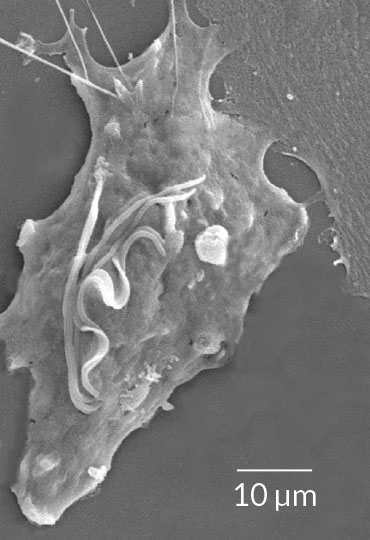
In fact, in lab dishes containing vaginal and cervical cells alongside beneficial lactobacilli and bacteria associated with vaginal infections, T. vaginalis diminishes the numbers of certain lactobacilli by more than 99 percent. Dessì thinks that the parasite might be acting as a sort of microbe farmer, shaping a vaginal community to be more hospitable to its needs. The parasite might do so, he speculates, by simply eating lactobacilli and other protective bacteria.
T. vaginalis can also play host to its own helpful microbes: bacteria called Mycoplasma hominis and a handful of viruses called TVVs, for Trichomonas vaginalis virus. Exactly how these microbes influence infection in humans isn’t fully understood, but the viruses seem to help the parasite stick to host cells and may also magnify inflammation and symptoms. Researchers know of at least four types of TVV and recently discovered another species of bacteria, Mycoplasma girerdii, hanging out with T. vaginalis, too.
“It is becoming like a zoo,” Simoes-Barbosa jokes. M. hominis can also work alone to cause sexually transmitted infections, accompanied by burning, pain and discharge like trichomoniasis. Dessì suspects the two microbes first met up in the reproductive tract and started cooperating, with the smaller bacterium either inside or alongside T. vaginalis. When inside, M. hominis gains a safe space to live, protected from the immune system and drug treatments.
But both may benefit from the partnership, Dessì says. “It’s like having one more player on your team.” For example, Dessì and collaborators reported in Frontiers in Microbiology in 2016 that when T. vaginalis in the lab carries M. hominis, the T. vaginalis makes more energy and grows faster. Dessì thinks the pair cooperate to collect a nutrient called arginine from the environment. Immune cells need arginine to make nitric oxide, which kills microbes. By eating the arginine, the microbes may be thwarting the immune system. Dessì can’t be sure that the same happens in a human infection, but he suspects M. hominis would make symptoms worse.
M. hominis, however, might not be entirely beneficial to T. vaginalis; the presence of M. hominis gets the attention of immune soldiers. Mercer and Johnson reported in their 2016 paper in PLOS Neglected Tropical Diseases that the parasite-bacterium pair together cause immune cells to spew more distress signals like IL-8, compared with T. vaginalis alone. Mercer thinks that M. hominis might help trigger the kind of immune response that remembers T. vaginalis and fights it off next time.
Stacking the deck
To devise new treatments for those who don’t get relief from existing drugs, or to develop a preventive vaccine, Dessì says, researchers need a better understanding of the interactions among T. vaginalis, the immune system and the other microbes involved.
For example, a vaccine that promotes neutrophil trogocytosis might be beneficial.
Meanwhile, Simoes-Barbosa’s work suggests that treating just T. vaginalis may not be enough. To keep the parasite from returning, some women may need treatments that promote a healthy, lactobacilli-heavy microbiome, too. Some might even need medicines that kill the M. hominis carried by the parasite.
That kind of therapy is far off, though, as there’s still a lot to learn about T. vaginalis. For now, our protective neutrophils, the parasite and the microbial hangers-on remain locked in a nearly even match. No one seems to dominate, says Johnson: “There’s just so many players.”
